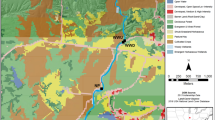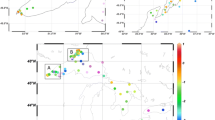Abstract
We compared extracellular enzyme activity (EEA) of microbial assemblages in river sediments at 447 sites along the Upper Mississippi, Missouri, and Ohio Rivers with sediment and water chemistry, atmospheric deposition of nitrogen and sulfate, and catchment land uses. The sites represented five unique river reaches—impounded and unimpounded reaches of the Upper Mississippi River, the upper and lower reaches of the Missouri River, and the entire Ohio River. Land use and river chemistry varied significantly between rivers and reaches. There was more agriculture in the two Upper Mississippi River reaches, and this was reflected in higher nutrient concentrations at sites in these reaches. EEA was highest in the two Upper Mississippi River reaches, followed by the lower Missouri River reach. EEA was generally lowest in the upper Missouri River reach. Canonical correlation analysis revealed a strong correlation between EEA and the suite of water and sediment chemistry variables, and the percent of the catchment in anthropogenically dominated land uses, including agriculture and urban development. Nutrient ratios of the waters and sediments suggested carbon (C), nitrogen (N), or phosphorus (P) limitation at a large number of sites in each reach. C-limitation was most pronounced in the unimpounded Mississippi River and lower Missouri River reaches; N-limitation was prevalent in the two Missouri River reaches; and P-limitation dominated the Ohio River. Linking microbial enzyme activities to regional-scale anthropogenic stressors in these large river ecosystems suggests that microbial enzyme regulation of carbon and nutrient dynamics may be sensitive indicators of anthropogenic nutrient and carbon loading.



Similar content being viewed by others
References
Ainsworth AM, Goulder R (2000) Downstream change in leucine aminopeptidase activity and leucine assimilation by epilithic microbiota along the River Swale, northern England. Sci Total Environ 251(252):191–204
Allen AP, Gillooly JF (2009) Towards an integration of ecological stoichiometry and the metabolic theory of ecology to better understand nutrient cycling. Ecol Lett 12:369–384
American Public Health Association (APHA) (1998) Standard Methods for the Examination of Water and Wastewater, 20th ed. (eds. L.S. Clesceri, A.E. Greenberg & A.D. Eaton). American Public Health Association, Washington, DC
Angradi TR (ed) (2006) Environmental monitoring and assessment program, Great River ecosystems field operations manual. EPA/620R/06/002. US Environmental Protection Agency, Office of Research and Development, Washington, DC. http://www.epa.gov/emap/greatriver/fom.html. Accessed 1 July 2008
Angradi TR, Bolgrien DW, Jicha TM, Hill BH, Pearson MS, Taylor DL, Schweiger EW, Shepard L, Batterman AL, Batterman SL, Moffett MF, Elonen CE, Anderson LE (2009) A monitoring and assessment program for the Great Rivers of the Upper Mississippi River basin, USA. Environ Monit Assess 152:425–442
Baker JL (1985) Sources and fates of materials influencing water quality in the agricultural midwest—management practices to reduce farm chemical losses with agricultural drainage. In: Perspectives on nonpoint source pollution. EPA 440/5-85/001. US Environmental Protection Agency, Office of Water, Washington, DC, pp 467–470
Bedford BL, Walbridge MR, Aldous A (1999) Patterns in nutrient availability and plant diversity of temperate North American wetlands. Ecology 80:2151–2169
Blenkinsopp SA, Lock MA (1990) The measurement of electron transport system activity in river biofilms. Water Res 24:441–445
Boschker HTS, Cappenberg TE (1998) Patterns of extracellular enzyme activities in littoral sediments of Lake Gooimeer, The Netherlands. FEMS Microbiol Lett 25:79–86
Broberg A (1985) A modified method for studies of electron transport system activity in freshwater sediments. Hydrobiologia 120:181–187
Burns A, Ryder DS (2001) Response of bacterial extracellular enzymes to inundation of floodplain sediments. Freshw Biol 46:1299–1307
Capone DG, Kiene RP (1988) Comparison of microbial dynamics in marine and freshwater sediments: contrasts in anaerobic carbon catabolism. Limnol Oceanogr 33:725–749
Chrzanowski TH, Keyle M (1996) Ratios of carbon, nitrogen and phosphorus in Pseudomonas fluorescens as a model for bacterial element ratios and nutrient regeneration. Aquat Microb Ecol 10:115–122
Cleveland CC, Liptzin D (2007) C:N:P stoichiometry in soil: is the a “Redfield ratio” for the microbial biomass? Biogeochemistry 85:235–252
Cotner JB, Wetzel RG (1991) Bacterial phosphatases from different habitats in a small, hardwater lake. In: Chrost RJ (ed) Microbial enzymes in aquatic environments. Springer-Verlag, New York, pp 60–83
Donner SD, Kucharik CJ, Foley JA (2004) Impact of changing land use practices on nitrate export by the Mississippi River. Global Biogeochem Cycles 18:1028–1048
Falkowski PG (2000) Rationalizing elemental ratios in unicellular algae. J Phycol 36:3–6
Fischer H, Kloep F, Wilzcek S, Pusch M (2005) A river’s liver—microbial processes within the hyporheic zone of a large lowland river. Biogeochemistry 76:349–371
Foreman CM, Franchini P, Sinsabaugh RL (1998) The trophic dynamics of riverine bacterioplankton: relationships among substrate availability, ectoenzyme kinetics and growth. Limnol Oceanogr 43:1344–1352
Goolsby DA, Battaglin WA, Lawrence GB, Artz RS, Aulenbach BT, Hooper RP, Keeney DR, Stensland GJ (1999) Flux and sources of nutrients in the Mississippi-Atchafalaya River basin. Topic 3 Report-Integrated assessment of hypoxia in the Gulf of Mexico. NOAA Coastal Ocean Program Decision Analyses Series no. 17, National Oceanographic and Atmospheric Administration, Silver Springs, Maryland
Guy HP (1969) Laboratory analysis—laboratory theory and methods for sediment analysis. US Geological Survey Techniques of Water-Resources Investigations, Book 5, Chap C1, 58 pp
Harbott EL, Grace MR (2005) Extracellular enzyme response to bioavailability of dissolved organic C in streams of varying catchment urbanization. J North Am Benthol Soc 24:588–601
Hill BH, Herlihy AT, Kaufmann PR (2002) Benthic microbial respiration in Appalachian Mountain, Piedmont, and Coastal Plains streams of the eastern USA. Freshw Biol 47:185–194
Hill BH, Elonen CE, Jicha TM, Cotter AM, Trebitz AS, Danz NP (2006) Sediment microbial enzyme activity as an indicator of nutrient limitation in Great Lakes coastal wetlands. Freshw Biol 51:1670–1683
Homer C, Huang C, Tang L, Wylie B, Coan M (2004) Development of a 2001 national land-cover database for the United States. Photogramm Eng Remote Sens 70:829–840
Hoppe H (1991) Microbial extracellular enzyme activity: a new key parameter in aquatic ecology. In: Chrost RJ (ed) Microbial enzymes in aquatic environments. Springer-Verlag, New York, pp 60–83
Howarth RW, Billen G, Swaney D, Townsend A, Jaworski N, Lajtha K, Downing JA, Elmgren R, Caraco N, Jordan T, Berendse F, Freney J, Kudeyarov V, Murdoch P, Zhao-Liang Z (1996) Regional nitrogen budgets and riverine N & P fluxes for the drainages to the North Atlantic Ocean: natural and human influences. Biogeochemistry 35:75–139
Hutchinson GE (1971) A treatise on limnology. Volume. I. Geography, physics, and chemistry. Wiley, New York
Jackson CR, Foreman CM, Sinsabaugh RL (1995) Microbial enzyme activities as indicators of organic matter processing in a Lake Erie coastal wetland. Freshw Biol 34:329–342
Kang H, Freeman C (1999) Phosphatase and arylsulphatase activities in wetland soils: annual variation and controlling factors. Soil Biol Biochem 31:449–454
Kang H, Freeman C, Park SS, Chun J (2005) N-acetylglucosaminidase activities in wetlands: a global survey. Hydrobiologia 532:103–110
Montuelle B, Volat B (1998) Impact of wastewater treatment plant discharge on enzyme activity in freshwater sediments. Ecotoxicol Environ Saf 40:154–159
National Atmospheric Deposition Program (2008) National atmospheric deposition program. Illinois State Water Survey, Champaign, IL. http://nadp.sws.uiuc.edu/
National Research Council (2002) The Missouri River ecosystem: exploring the prospects for recovery. Committee on Missouri River Ecosystem Science. National Research Council, Washington, DC, p 173
Nausch M, Nausch G (2000) Stimulation of peptidase activity in nutrient gradients in the Baltic Sea. Soil Biol Biochem 32:1973–1983
Packard TT (1971) The measurement of respiratory electron transport activity in marine phytoplankton. J Mar Res 29:235–244
Redfield AC (1958) The biological control of chemical factors in the environment. Am Sci 46:205–221
Rohlf FJ, Sokal RR (1969) Statistical tables. WH Freeman and Company, San Francisco
Shackle VJ, Freeman C, Reynolds B (2000) Carbon supply and the regulation of enzyme activity in constructed wetlands. Soil Biol Biochem 32:1935–1940
Sinsabaugh RL, Findlay SG (1995) Microbial production, enzyme activity, and carbon turnover in surface sediments of the Hudson River estuary. Microb Ecol 30:127–141
Sinsabaugh RL, Foreman CM (2001) Activity profiles of bacterioplankton in a eutrophic river. Freshw Biol 46:1239–1249
Sinsabaugh RL, Foreman CM (2003) Integrating dissolved organic matter metabolism and microbial diversity: an overview of conceptual models. In: Findlay SG, Sinsabaugh RL (eds) Aquatic ecosystems: interactivity of dissolved organic matter. Academic Press, New York, pp 425–454
Sinsabaugh RL, Moorhead DL (1994) Resource allocation to extracellular enzyme production: a model for nitrogen and phosphorus control of litter decomposition. Soil Biol Biochem 26:1305–1311
Sinsabaugh RL, Findlay S, Franchini P, Fisher D (1997) Enzymatic analysis of riverine bacterioplankton production. Limnol Oceanogr 42:29–38
Sinsabaugh RL, Carreiro MM, Alvarez S (2002) Enzyme and microbial dynamics of litter decomposition. In: Burns RG, Dick RP (eds) Enzymes in the environment: activity ecology & applications. Marcel Dekker, Inc, New York, pp 249–265
Sinsabaugh RL, Lauber CL, Weintraub MN, Ahmed B, Allison SD, Crenshaw C, Contosta AR, Cusack D, Frey S, Gallo ME, Gartner TB, Hobbie SE, Holland K, Keeler BL, Powers JS, Stursova M, Takacs-Vesbach C, Waldrop MP, Wallenstein MD, Zak DR, Zeglin LH (2008) Stoichiometry of soil enzyme activity at global scale. Ecol Lett 11:1252–1264
Sterner RW, Elser JJ (2002) Ecological stoichiometry: the biology of elements from molecules to the biosphere. Princeton University Press, Princeton, NJ
Sundareshwar PV, Morris JT, Koepfler E, Fornwalt B (2003) Phosphorus limitation of coastal ecosystem processes. Science 299:563–565
US Geological Survey (2001) National land-cover database for the United States (2001) US Geological Survey, Reston, Virginia. http:\\www.mrlc.gov
Trevors JT, Mayfield CI, Inniss WE (1982) Measurement of electron transport system (ETS) activity in soil. Microb Ecol 8:163–168
Turner RE, Rabalais NN (2003) Linking landscape and water quality in the Mississippi River basin for 200 years. Bioscience 53:563–572
Turner RE, Rabalais NN, Justic’ D, Dortch Q (2003) Future aquatic nutrient limitations. Mar Pollut Bull 46:1032–1034
Wetzel RG (1991) Extracellular enzymatic interactions: storage, redistribution, and interspecific communication. In: Chrost RJ (ed) Microbial enzymes in aquatic environments. Springer-Verlag, New York, pp 6–28
Wright AL, Reddy KR (2001) Phosphorus loading effects on extracellular enzyme activity in Everglades wetland soils. Soil Sci Soc Am J 65:588–595
Acknowledgements
We thank Xiaoli Yuan (USGS Upper Midwest Environmental Sciences Center) for analytical chemistry support; Marlys Cappaert and her data team (CSC Corp.) for database support; and Tatiana Nawrocki, Matthew Starry, Roger Meyer, and Jesse Adams (CSC Corp.) for GIS support. Tony Olsen supervised the creation of the survey design. We are especially indebted to the field crews who collected the data. The information in this document has been funded wholly by the U.S. Environmental Protection Agency. It has been subjected to review by the National Health and Environmental Effects Research Laboratory and approved for publication. Approval does not signify that the contents reflect the views of the Agency, nor does mention of trade names or commercial products constitute endorsement or recommendation for use.
Author information
Authors and Affiliations
Corresponding author
Rights and permissions
About this article
Cite this article
Hill, B.H., Elonen, C.M., Jicha, T.M. et al. Sediment microbial enzyme activity as an indicator of nutrient limitation in the great rivers of the Upper Mississippi River basin. Biogeochemistry 97, 195–209 (2010). https://doi.org/10.1007/s10533-009-9366-0
Received:
Accepted:
Published:
Issue Date:
DOI: https://doi.org/10.1007/s10533-009-9366-0




